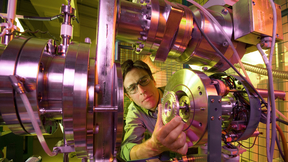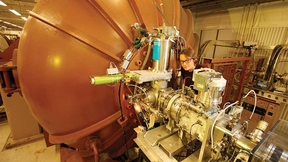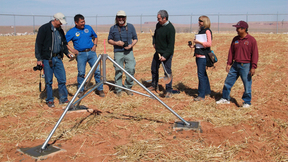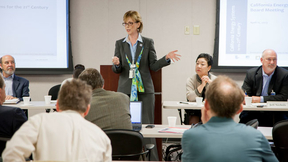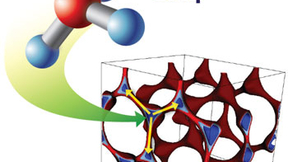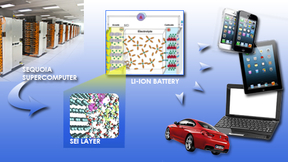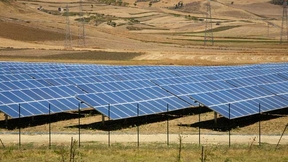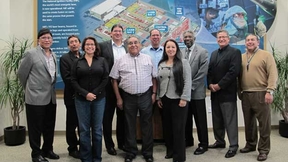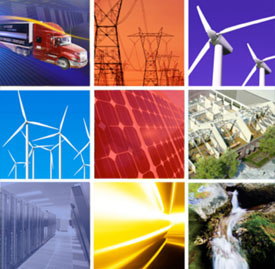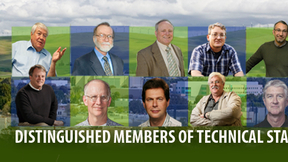Back
Energy
LLNL scientists find precipitation, global warming link
The rain in Spain may lie mainly on the plain, but the location and intensity of that rain is changing not only in Spain but around the globe.A new study by Lawrence Livermore National Laboratory scientists shows that observed changes in global (ocean and land) precipitation are directly affected by human activities and cannot be explained by natural variability alone. The…
Lawrence Livermore study finds human activity affects vertical structure of atmospheric temperature
Human influences have directly impacted the latitude/altitude pattern of atmospheric temperature. That is the conclusion of a new report by scientists from Lawrence Livermore National Laboratory and six other scientific institutions. The research compares multiple satellite records of atmospheric temperature change with results from a large, multi-model archive of…
Lawrence Livermore engineering team makes breakthrough in solar energy research
LIVERMORE, Calif. - The use of plasmonic black metals could someday provide a pathway to more efficient photovoltaics (PV) -- the use of solar panels containing photovoltaic solar cells -- to improve solar energy harvesting, according to researchers at Lawrence Livermore National Laboratory (LLNL).The LLNL Materials Engineering Division (MED) research team has made…
Lawrence Livermore celebrates 25 years of carbon dating
From developing the first accelerator mass spectrometer for use in the biology field to tracking radionuclides from the Dai-ichi Nuclear Power Plant disaster, the Laboratory's Center for Accelerator Mass Spectrometry (CAMS) has spent 25 years in the spotlight of not only dating ancient artifacts but solving global challenges.CAMS is celebrating its 25th anniversary this…
Carbon dating impacts non-proliferation, drug research and climate change
Research conducted at the Center for Accelerator Mass Spectrometry (CAMS) spans the universe, the depths of time and everything in between. Although not all elements and isotopes are able to be utilized by AMS, CAMS' researchers make the most of what nuclear physics has given them.Here is a sampling of some of the many ways CAMS is utilized, along with the important…
Americans continue to use more renewable energy sources
Americans used more natural gas, solar panels and wind turbines and less coal to generate electricity in 2012, according to the most recent U.S. energy charts released by Lawrence Livermore National Laboratory . Each year, the Laboratory releases energy flow charts that track the nation's consumption of energy resources. Natural gas use is up particularly in the…
Livermore develops the world's deepest ERT imaging system for CO2 sequestration
LIVERMORE, Calif.-- Lawrence Livermore National Laboratory researchers have broken the record for tracking the movement and concentration of carbon dioxide in a geologic formation using the world's deepest Electrical Resistance Tomography (ERT) system.The research provides insight into the effects of geological sequestration to mitigate the impact of greenhouse gases.The…
Livermore scientists develop CO2 sequestration technique that produces 'supergreen' hydrogen fuel, offsets ocean acidification
LIVERMORE, Calif. -- Lawrence Livermore scientists have discovered and demonstrated a new technique to remove and store atmospheric carbon dioxide while generating carbon-negative hydrogen and producing alkalinity, which can be used to offset ocean acidification.The team demonstrated, at a laboratory scale, a system that uses the acidity normally produced in saline water…
Lab partners with Navajo Nation on uranium mine project
A team of Lab scientists last month visited the Navajo Nation Abandoned Mine Lands Reclamation Project (Navajo AML) in Shiprock, N.M. to conduct work on a joint project. The partnership will develop an environmental and hydrological monitoring program for a uranium mine waste disposal cell in the Tse Tah area of northeast Arizona and several other mining areas. The Lab…
CES-21 board meets at Lawrence Livermore
The California Energy System for the 21st Century (CES-21) Board of Directors convened their latest public meeting at Livermore Valley Open Campus (LVOC) last Thursday. Following welcoming remarks by Computation Associate Director Dona Crawford and comments by CES-21 Executive Director Steve Larson, the board began the process of reviewing different aspects of the pending…
Lawrence Livermore scientists discover new materials to capture methane
Scientists at Lawrence Livermore National Laboratory (LLNL) and UC Berkeley and have discovered new materials to capture methane, the second-highest concentration greenhouse gas emitted into Earth's atmosphere. Methane is a substantial driver of global climate change, contributing 30 percent of current net climate warming. Concern over methane is mounting, due to leaks…
LLNL and Berkeley scientists discover new materials to capture methane
Scientists at Lawrence Livermore National Laboratory (LLNL) and UC Berkeley and have discovered new materials to capture methane, the second highest concentration greenhouse gas emitted into the atmosphere. Methane is a substantial driver of global climate change, contributing 30 percent of current net climate warming. Concern over methane is mounting, due to leaks…
LLNL leads new initiative to improve lithium-ion batteries
A Lawrence Livermore team is working to improve lithium-ion battery performance, lifetime, and safety.Working with Lawrence Berkeley National Laboratory (LBNL), the scientists are developing a new methodology for performing first-principles quantum molecular dynamics (QMD) simulations at an unprecedented scale to understand key aspects of the chemistry and dynamics in…
Lab sustainability efforts move toward solar energy: DOE issues call for proposals
The Laboratory is planning to establish and use an onsite solar electrical-generation system that not only will provide a clean, renewable source of onsite energy, but an additional capability for LLNL energy research and development efforts. This move toward solar energy will enhance the Lab's sustainability initiatives and performance, with a focus on renewable energy…
Tribal Clean Energy Resource members visit LLNL
Advisory board members from the newly created Tribal Clean Energy Resource Center (TCERC) visited the Laboratory last week. Lead by Hopi Chairman LeRoy Shingoitewa and William Cornelius, Oneida Tribe of Indians of Wisconsin, the TCERC members got a firsthand tour of the Laboratory. The TCERC board members met all week with several hundred tribes at the National Congress…
Lab hosts workshop with research universities to address energy challenges
To lay the foundation for stronger collaborations to address national energy problems, the Laboratory recently invited researchers from leading universities to exchange ideas and mathematical approaches for leveraging high performance computing, and to identify areas for cooperative research. "This exchange of ideas is a great opportunity to build on existing…
The future of power
What is power, and how can the United States effectively project power in the information or cyber age? This was the focus of a recent lecture by Joseph Nye as part of a seminar series on U.S. foreign policy sponsored by the Center for Global Security Research. Nye has had a significant influence, stretching over more than 40 years, on how the U.S. thinks about foreign…
Lawrence Livermore teams with industry to advance energy technologies using high performance computing
LIVERMORE, Calif. -- Lawrence Livermore National Laboratory (LLNL) today announced the selection of six industry projects for the advancement of energy technologies using high performance computing (HPC). Called the "hpc4energy incubator," this pilot program aims to innovate and accelerate the development of energy technology and boost U.S. economic competitiveness in the…
Lab co-sponsors North Dakota energy technology symposium
Tomas Diaz de la Rubia, the Lab's deputy director for Science and Technology, discussed Monday how high performance computer modeling and simulation can accelerate the development of clean energy technologies in a keynote address at North Dakota State University (NDSU) in Fargo, N.D. The Laboratory was a co-sponsor of the "North Dakota Energy Symposium: Using Technology to…
Ten scientists named Distinguished Members of Technical Staff
Ten Laboratory researchers have been named Distinguished Members of Technical Staff (DMTS) for their extraordinary scientific and technical contributions to the Laboratory and its missions as acknowledged by their professional peers and the larger community. Jim Candy of the Engineering Directorate, John Castor of the Weapons and Complex Integration Principal Directorate,…





